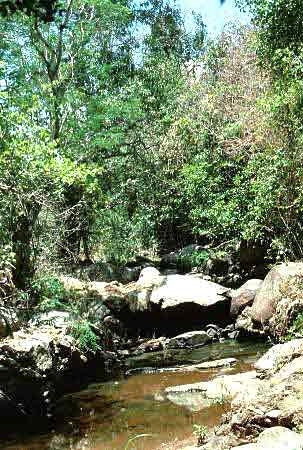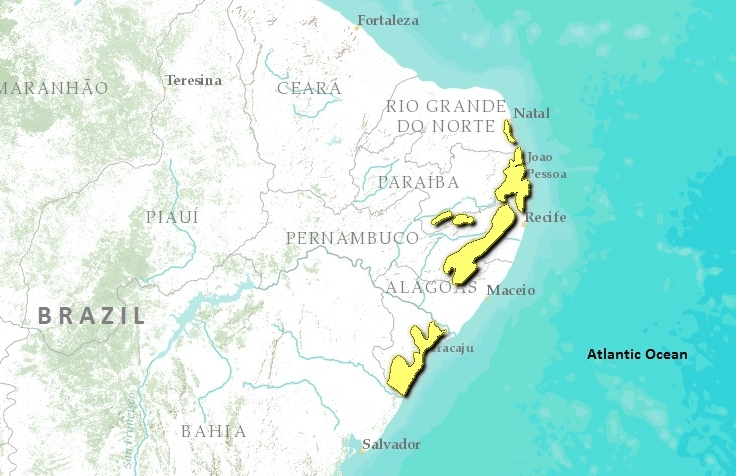Pernambuco interior forests
Characterized predominantly by low-elevation plateaus, this narrow region in northeastern Brazil separates the Pernambuco coastal forests and Caatinga ecoregions. This ecoregion serves as a transition from the coastal region to dry forests. Biodiversity is rich, because the flora and fauna of both regions characterizes this ecoregion. Only five percent of the original forest remains; deforestation, agriculture, and cattle ranching have completely destroyed most of the land. Patches of forest, rarely over 1 km2, make up most of the remaining original habitat. Three protected areas, covering only ninety square kilometers combined, constitute most of the remaining forest. The rest are patches of forest rarely.
Location and General Description
Pernambuco interior forests are located in a narrow strip (approximately 50 km wide) between the ecoregions of Pernambuco coastal forests and Caatinga, in northeastern Brazil. In the north, its border is the Curimataú River; in the south, it is limited by the large São Francisco River. The climate is tropical with an annual rainfall around 1,250 to 1,750 millimeters (mm) and a dry period from October through March. Forests cover both sedimentary plateaus and ancient slopes of the Borborema Plateau. Tropical nutrient-impoverished soils (yellow-red latosols, podzols and lithosols) are dominant. Forests spread from low-elevation plateaus to the windward slopes of Borborema at 600 to 800 meters (m) elevation. The main type of vegetation is the Atlantic semi-deciduous forest, a four-strata vegetation with emergent trees taller than 35 m. Emergent and canopy layers include characteristic tree species belonging to the following families: Anacardiaceae (Astronium fraxinifolium), Leguminosae (Enterolobium contortisiliquum), Boraginaceae (Cordia trichotoma), and Bignoniaceae (Tabebuia chrysotricha). Understory vegetation strata are rich in myrtaceae and rubiaceae species. This ecoregion shares most of its biota with Pernambuco coastal forests, but the presence of unique transition plant communities mixing species of Atlantic forests and Caatinga dry forests sets this ecoregion apart from any other in the Atlantic forest complex.
Biodiversity Features
Based on the ranges of endemic species of several groups of organisms, Pernambuco interior forests and Pernambuco coastal forests make up a single center of endemism, named "Pernambuco Center". The relationships between the biota of these two [[ecoregion]s] have not been adequately assessed, but there is some evidence that interior forests are composed of a subset of the flora of coastal forests plus a unique set of species that inhabits transitional environments. In general, far less known about these interior forests from a scientific viewpoint than the coastal forests, although recent studies have identified new species of flowering plants in the interior forests. These interior forests harbor populations of several threatened species of plants. The largest populations of Caesalphinia echinata, a tree known as Brazil wood or "Pau-Brasil," are found mostly in the interior forests. This is the tree, which because of its abundance and economic importance, gave its name to the country. Several extraordinary avian endemics are found in the interior forests, although most of them are also found in the coastal forests. Examples are buff-breasted tody-tyrant (Hemitriccus mirandae), white-winged cotinga (Xipholena atropurpurea), seven-colored tanager (Tangara fastuosa), and yellow-faced siskin (Carduelis yarrellii).
Current Status
Deforestation for fuel, timber, agriculture, and cattle ranching has removed 95 percent of the original vegetation. Today, most of the forest is represented by small (1-10 ha), isolated, floristically impoverished fragments, and it is difficult to discern without careful botanic studies which are primary and which are secondary forests. Forest remnants comprise approximately 900 km2 of semi-deciduous forests and 420 km2 of ecotonal vegetation (Atlantic forest transition to Caatinga dry forest). There are only three protected areas, and they cover about 90 km2 of semi-deciduous forest. The most important reserve is Pedra Talhada Biological Reserve, in Quebrangulo, Alagoas. It has been indicated as one of the more important areas for protection of threatened birds in South America.
Types and Severity of Threats
Raising cattle and agriculture represent both the ongoing and the future threats with potential of extirpating all remaining forests. Such activities will increase the pressure on timber trees and game species (large frugivorous birds, primates and large rodents), almost completely extirpated in this ecoregion.
Justification of Ecoregion Delineation
According to many authors, Pernambuco interior forests comprise a well delimited belt of Atlantic dry forests set between the humid Atlantic forest and the Caatinga dry forest. This northern interior patch of Brazil’s Mata Atlantica forests are unique in floral and faunal endemism. Much of the current vegetation has been converted to agriculture, so linework for this ecoregion was derived from IBGE to estimate historic ranges by following their classification of "seasonal semideciduous forest: secondary vegetation and agricultural activity" and "seasonal forest – savanna transition" in the state of Pernambuco, Brazil. Linework was reviewed and modified during an ecoregional workshop covering Brazil’s Atlantic forests. Results of this workshop are also available.
Additional Information on this Ecoregion
- For a shorter summary of this entry, see the WWF WildWorld profile of this ecoregion.
- To see the species that live in this ecoregion, including images and threat levels, see the WWF Wildfinder description of this ecoregion.
- World Wildlife Fund Homepage
Further Reading
- Andrade-Lima, D.A. 1957. Estudos fitogeográficos de Pernambuco. Boletim do Instituto de Pesquisas Agronômicas de Pernambuco 2:1-44.
- Brown, Jr. K.S. 1987. Biogeography and evolution of neotropical butterflies. In T.C. Whitmore, and G.T. Prance, editors, Biogeography and quaternary history in tropical America. Claredon Press, Oxford. pp. 66-104. ISBN: 0198545460
- Coimbra-Filho, A. F. & Câmara, I.G. 1996. Os limites originais do Bioma Mata Atlântica na região Nordeste do Brasil. FBCN, Rio de Janeiro.
- Conservation International do Brazil, Fundacao SOS Mata Atlantica, Fundacao Biodiversitas, Instituto de Pesquisas Ecologicas, Secretaria do Meio Ambiente do Estado de Sao Paulo, SEMAD/Instituto Estadual de Florestas-MG. Brasilia. 1999. Avaliacao e acoes prioritarias para a conservacao de biodiversidade de Mata Atlantica e Campos Sulinos, MMA/SBF, 2000. 40p.
- Experts workshop for ecoregional priority setting. 10-14 August, 1999, Atibaia, Sao Paulo, Brazil
- Filho, L.E.M., G.V. Somner, and A.L. Peixoto. 1992. Centuria Plantarum Brasilienum Exstintionis Miniata. Sociedade Botânica do Brasil, Rio de Janeiro.
- Fundação Instituto Brasilero de Geografia Estatástica-IBGE. 1993. Mapa de vegetação do Brasil. Map 1:5,000,000. Rio de Janeiro, Brazil.
- Haffer, J. 1987. Biogeography of neotropical birds. Pages 105-150 in T.C. Whitmore, and G.T. Prance, editors, Biogeography and quaternary history in tropical America. Claredon Press, Oxford. ISBN: 0198545460
- IBGE. 1985. Atlas Nacional do Brasil: Região Nordeste. IBGE, Rio de Janeiro.
- Lima, A.R., and J.P.R. Capobianco (Org.). 1997. Mata Atlântica: avanços legais e institucionais para sua conservação. Documentos do ISA n° 4.
- Prance, G.T. 1987. Biogeography of neotropical plants. Pages 175-196 in T.C. Whitmore, and G.T. Prance, editors, Biogeography and quaternary history in tropical America. Claredon Press, Oxford. ISBN: 0198545460
- Sales, M.F., S.J. Mayo, and M.J.N. Rodal. 1998. Plantas vasculares das florestas serranas de Pernambuco: Um checklist da flora ameaçada dos Brejos de Altitude, Pernambuco-Brasil. Imprensa Universitária-UFRPE, Recife.
- Silva, J.M.C. and M. Tabarelli. 2000. Tree species impoverishment and the future flora of the Atlantic forest of northeast Brazil. Nature 404:72-74.
- SOS MATA ATLÂNTICA. 1993. Mapa de remanescentes da floresta Atlântica nordestina. In: Sociedade Nordestina de Ecologia, Conservation International e Fundação Biodiversitas, editor. Workhop Prioridades para a Conservação da Floresta Atlântica do Nordeste, Recife. http// www.bdt.org
- Veloso, H. P., A.L.R. Rangel-Filho, and J.C.A. Lima. 1991. Classificação da vegetação brasileira adaptada a um sistema universal. IBGE, Rio de Janeiro.
- Wege, D.C., and A.J. Long.. 1993. Key areas for threatened birds in the neotropics. BirdLife Conservation Series No. 5. ISBN: 0946888310
| Disclaimer: This article is taken wholly from, or contains information that was originally published by, the World Wildlife Fund. Topic editors and authors for the Encyclopedia of Earth may have edited its content or added new information. The use of information from the World Wildlife Fund should not be construed as support for or endorsement by that organization for any new information added by EoE personnel, or for any editing of the original content. |

